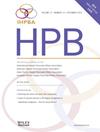Long-term clinical outcomes of pancreatic cystic lesions in liver transplant patients
IF 2.4
3区 医学
Q2 GASTROENTEROLOGY & HEPATOLOGY
引用次数: 0
Abstract
Background
Pancreatic cystic lesions (PCL) are often incidentally diagnosed in transplant patients, although long-term impact in this chronically immunosuppressed population remains unclear. This study examines long-term malignant potential and outcomes of PCL in orthotopic liver transplant (OLT) patients.
Methods
A retrospective study of 1110 patients who underwent OLT from 2011 to 2017 at a tertiary referral center was performed. Demographic, imaging, and outcomes data were examined.
Results
86 OLT patients with 148 PCL were identified. Median follow up after PCL identification was 7.6 years (IQR 5.7–9.7). Most cysts decreased in size (45%) or remained stable (30.2%). Only 24% of PCL increased in size, with average growth of 2.7 mm/year. Based on American College of Gastroenterology (ACG) 2018 guidelines, 20 patients (23%) developed high-risk imaging characteristics. Of 16 endoscopic ultrasounds (EUS) performed, 1 patient was diagnosed with pancreatic adenocarcinoma. There were no pancreas-specific causes of death and no survival differences in OLT patients with and without PCL on multivariate analysis.
Conclusion
There is a low incidence of malignant transformation of PCL in OLT patients and no survival disadvantage at long-term follow up despite immunosuppression. PCL in OLT patients should be managed under similar guidelines as immunocompetent patients.
肝移植患者胰腺囊性病变的长期临床结果。
背景:胰腺囊性病变(PCL)经常在移植患者中偶然被诊断出来,尽管对这种慢性免疫抑制人群的长期影响尚不清楚。本研究探讨原位肝移植(OLT)患者PCL的长期恶性潜能和预后。方法:对2011年至2017年在三级转诊中心接受OLT治疗的1110例患者进行回顾性研究。检查了人口统计学、影像学和结局数据。结果:86例OLT患者共鉴定出148个PCL。确诊后中位随访时间为7.6年(IQR为5.7-9.7)。大多数囊肿变小(45%)或保持稳定(30.2%)。只有24%的PCL尺寸增加,平均增长2.7毫米/年。根据美国胃肠病学学会(ACG) 2018年指南,20名患者(23%)出现高风险影像学特征。在16例超声内镜检查中,1例被诊断为胰腺腺癌。在多变量分析中,有和没有PCL的OLT患者没有胰腺特异性死亡原因,生存率也没有差异。结论:OLT患者PCL恶性转化发生率低,尽管免疫抑制,但长期随访无生存劣势。OLT患者的PCL应按照与免疫正常患者相似的指导方针进行处理。
本文章由计算机程序翻译,如有差异,请以英文原文为准。
求助全文
约1分钟内获得全文
求助全文
来源期刊

Hpb
GASTROENTEROLOGY & HEPATOLOGY-SURGERY
CiteScore
5.60
自引率
3.40%
发文量
244
审稿时长
57 days
期刊介绍:
HPB is an international forum for clinical, scientific and educational communication.
Twelve issues a year bring the reader leading articles, expert reviews, original articles, images, editorials, and reader correspondence encompassing all aspects of benign and malignant hepatobiliary disease and its management. HPB features relevant aspects of clinical and translational research and practice.
Specific areas of interest include HPB diseases encountered globally by clinical practitioners in this specialist field of gastrointestinal surgery. The journal addresses the challenges faced in the management of cancer involving the liver, biliary system and pancreas. While surgical oncology represents a large part of HPB practice, submission of manuscripts relating to liver and pancreas transplantation, the treatment of benign conditions such as acute and chronic pancreatitis, and those relating to hepatobiliary infection and inflammation are also welcomed. There will be a focus on developing a multidisciplinary approach to diagnosis and treatment with endoscopic and laparoscopic approaches, radiological interventions and surgical techniques being strongly represented. HPB welcomes submission of manuscripts in all these areas and in scientific focused research that has clear clinical relevance to HPB surgical practice.
HPB aims to help its readers - surgeons, physicians, radiologists and basic scientists - to develop their knowledge and practice. HPB will be of interest to specialists involved in the management of hepatobiliary and pancreatic disease however will also inform those working in related fields.
Abstracted and Indexed in:
MEDLINE®
EMBASE
PubMed
Science Citation Index Expanded
Academic Search (EBSCO)
HPB is owned by the International Hepato-Pancreato-Biliary Association (IHPBA) and is also the official Journal of the American Hepato-Pancreato-Biliary Association (AHPBA), the Asian-Pacific Hepato Pancreatic Biliary Association (A-PHPBA) and the European-African Hepato-Pancreatic Biliary Association (E-AHPBA).
 求助内容:
求助内容: 应助结果提醒方式:
应助结果提醒方式:


